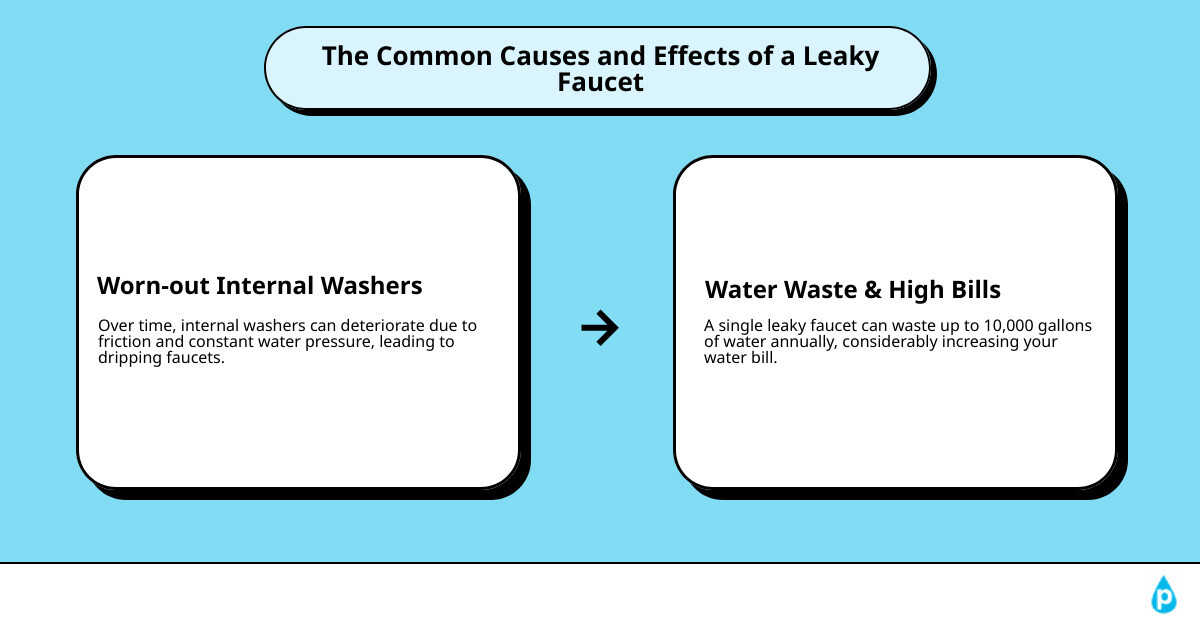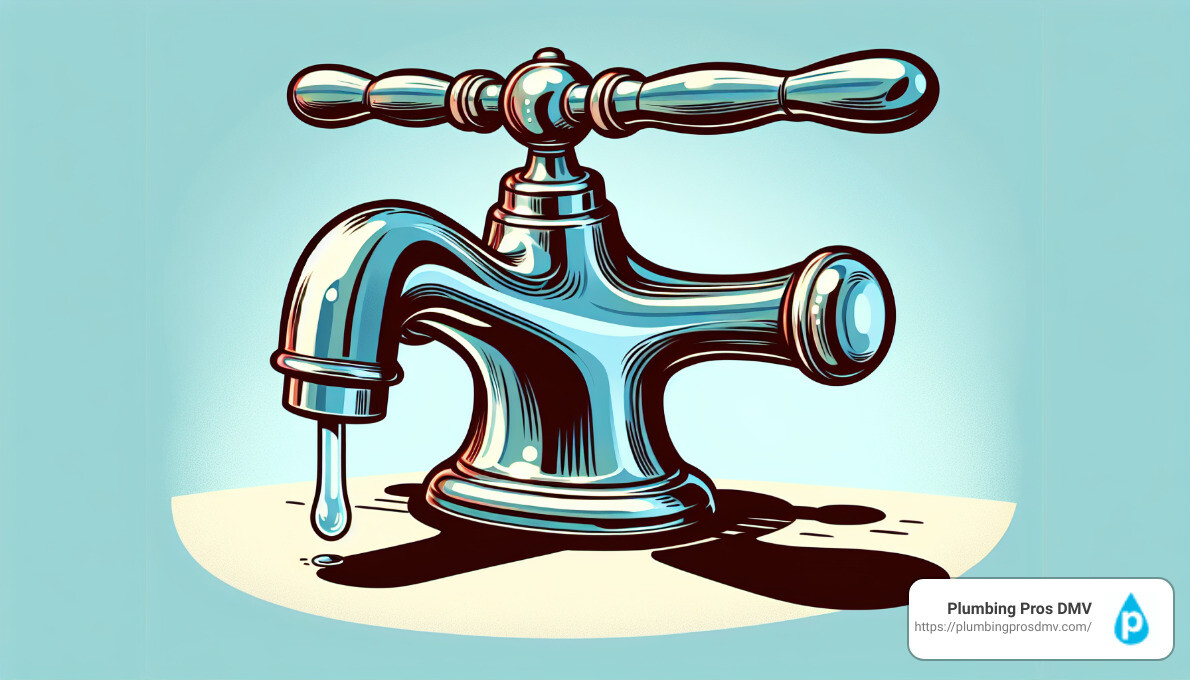Introduction
Let’s be honest, is there anything more annoying than the persistent drip-drip-drip of a bathroom sink faucet leaking from the spout? This common but infuriating problem not only disrupts the tranquility of your bathroom environment, but also conservatively wastes up to 10,000 gallons of water a year, making a significant impact on both your water bill and the environment.
Understanding the Importance of Fixing a Leaky Faucet
In the grand scheme of life’s little annoyances, it’s tempting to ignore a leaky faucet. After all, it’s not exactly a burst pipe or an overflowing toilet, and tightening up a few connections or replacing a washer now and then might seem like a nuisance, right? Think again! Ensuring your faucets are tightly sealed and leak-free is crucial in preempting far more serious damage to your home’s plumbing system, as well as saving you from a rapidly rising water bill.
The most common causes of a leaking faucet include worn-out internal washers, worn out O-rings and corroded valve seats. Fortunately, even for those of us who are not exactly confident DIY handyperson, these components are generally easy to replace, making this an entirely manageable home repair project.

But before we can dive into repairing your leaky faucet, it’s important to identify the type of faucet you have. This is because different faucet types including compression, cartridge, ball, and ceramic-disk faucets require distinct approaches for effective repair.
Getting your home back to a leak-free state may feel like a daunting prospect, but don’t worry, with our guidance, you’ll be able to conquer that prolonging drip in no time. We at Plumbing Pros DMV are committed to guiding you step-by-step, ensuring we address your problem and end your agony.
Stay with us as we dive headfirst into leaky faucets and especially in this article how to fix the all too common problem of a bathroom sink faucet leaking from the spout. Let’s get started!
Identifying the Type of Faucet You Have
Before we get into the nitty-gritty of the repair process, it’s important to identify the type of faucet you have in your bathroom. This information is crucial as it guides us in the right direction for the repair. As experts at Plumbing Pros DMV, we’ve found that most bathroom sink faucets fall into two main categories: Single Handle Faucets and Double Handle Faucets.
Single Handle Faucets

Single handle faucets are quite popular due to their sleek design and simple operation. These faucets have one handle that controls both the hot and cold water flow. The handle moves up and down to control the water volume and left or right to adjust the temperature. If your bathroom sink faucet leaking from the spout has a single handle, it could be due to a worn-out cartridge or O-ring, which we’ll discuss more in the repair steps.
Double Handle Faucets

Double handle faucets, as the name suggests, have two handles – one for hot water and the other for cold water. These faucets are a bit more traditional and provide separate control for the temperature of the water. If your double handle bathroom sink faucet is leaking from the spout, it could be due to a faulty stem or worn out washers in one or both of the handles.
While these are the two most common types of bathroom sink faucets, there are also other specialty types like the ball faucet, cartridge faucet, and ceramic-disk faucet. Each of these has its unique structure and operation.
Knowing your type of faucet is the first step towards a successful DIY repair process. But if you’re unsure about the type of faucet you have, don’t worry. At Plumbing Pros DMV, we are always ready to help. Our expert, James D. – CEO, has dealt with numerous types of faucets and is well equipped to guide you through the identification process.
In the next section, we will discuss how to prepare for the repair process and the tools you will need.
Preparing for the Repair
Before diving into the repair, it’s wise to gather all necessary tools and supplies. Being well-prepared can save you time and prevent unnecessary frustration.
Gathering the Necessary Tools and Supplies
To fix a bathroom sink faucet leaking from spout, you will need the following items:
- Adjustable wrench
- Screwdrivers (both flathead and Phillips)
- Plumber’s tape (Teflon tape)
- Replacement parts (washers, O-rings, springs, ceramic disks, etc.)
- Towels or rags
- Bucket or container
- Penetrating oil (e.g., WD-40)
- Adjustable pliers
- Allen wrench (hex key)
The replacement parts you may need will depend on the type of faucet you have. Be sure to identify your faucet type accurately to gather the correct parts. If you’re unsure about what you need, don’t hesitate to reach out to us at Plumbing Pros DMV. We’re here to help guide you through the process.
Turning Off the Water Supply
The first step in any plumbing repair is to shut off the water supply. This prevents any unwanted water spillage which could lead to further problems.
For most bathroom sinks, the shut-off valves are located under the sink. Turn these valves clockwise to cut off the water supply. If for any reason you can’t turn off the water from these valves, you may need to turn off the main water supply to your home.
Safety is paramount. If you’re unsure or uncomfortable with any steps in the process, it’s best to call in a professional plumber. Our team at Plumbing Pros DMV is always ready to assist and ensure your plumbing issues are resolved quickly and efficiently.
In the next section, we’ll walk you through the step-by-step process of fixing your leaky bathroom sink faucet.
Step-by-Step Guide to Fixing a Leaky Bathroom Sink Faucet
Fixing a bathroom sink faucet leaking from spout can be simpler than you might think. With the right tools and a bit of patience, you can tackle this task yourself.
Removing the Faucet Handle
First, you’ll need to remove the faucet handle. Depending on your faucet type, the process may vary. For faucets with a set screw behind the handle, use a hex key or Allen wrench to remove it. If the handle has a top screw cover, pry it off with a flat screwdriver, then use a Phillips head screwdriver to loosen the screw underneath.
Tip: Ensure you place a towel or sink stopper over the drain to prevent any screws or small parts from falling into it.
Inspecting and Replacing the Cartridge or Stem
Once the handle is off, you can access the faucet cartridge or stem. This is the part that controls the flow of hot and cold water. Use a wrench to loosen the packing nut in the handle assembly, then gently pull the part straight up and out.
Inspect the cartridge or stem for any signs of wear or damage. If it’s the culprit for your leak, replace it. Cartridges and stems come in many shapes and sizes, so bring the old one to the store to get the exact match.
Checking and Replacing the O-Rings
Next, check the O-rings around the housing. O-rings that look damaged or worn should be replaced as they can cause leaks. Ensure the new O-rings are positioned correctly before moving to the next step.
Reassembling the Faucet
Once the cartridge or stem and O-rings are replaced, it’s time to reassemble your faucet. Start by inserting the new cartridge or stem back into the assembly, making sure it aligns correctly. Then, reattach the handle and screw it back into place.
It’s important to take your time and not force any parts. If you encounter any resistance or if parts don’t fit back together easily, double-check each step to ensure everything is correctly assembled.
Note: If you continue to experience issues despite following these steps, it may be best to call in the professionals. At Plumbing Pros DMV, we have the expertise to quickly diagnose and fix any plumbing issues, ensuring your home’s plumbing system stays in top shape. Contact us today for any of your plumbing needs.
In the next section, we’ll show you how to test the faucet and clean the aerator to ensure optimal performance.
Testing the Faucet and Cleaning the Aerator
Once you’ve reassembled the faucet, it’s time to put it to the test and make sure that your bathroom sink faucet is no longer leaking from the spout.
Running Hot and Cold Water Through the Faucet
The first step is to turn the water supply back on. Start by running both hot and cold water through the faucet for a few minutes. This not only helps to ensure that the leak has been fixed but also serves to flush out any debris that might have accumulated during the repair process. If the faucet operates smoothly without any leaks, well done – you’ve successfully fixed the leak!
However, if you notice that the water flow is not consistent or you’re still experiencing a leak, you may need to take another look at the internal components of the faucet or contact a professional plumber for assistance.
Cleaning the Aerator to Prevent Clogs
The final step in this repair process is to clean the aerator. The aerator is the component that screws onto the end of the faucet spout. Its main function is to mix air with the water as it flows out, preventing splashing and reducing water usage.
Over time, mineral buildup can clog the aerator, affecting the water pressure and flow. To clean it, simply unscrew it from the faucet spout and rinse it under running water. If the buildup is more severe, consider soaking the aerator in vinegar to loosen the deposits. After cleaning, screw the aerator back onto the faucet spout.
Regular maintenance of your faucet, including cleaning the aerator, can prevent future leaks and ensure optimal performance.
However, if your bathroom sink faucet continues leaking from the spout despite your best efforts, don’t hesitate to reach out to us at Plumbing Pros DMV. We’re here to provide fast, reliable, and effective plumbing solutions in Alexandria VA, Germantown MD, Manassas VA, Centreville VA, Gainesville VA, and surrounding areas. We understand that plumbing issues can be frustrating, so let us take the hassle off your hands.
When to Call a Professional Plumber
While it’s commendable to take on the task of fixing a bathroom sink faucet leaking from the spout yourself, there are times when it’s simply best to call in the pros.
Persistent Leaks After DIY Repair
If your faucet continues to leak even after you’ve replaced worn-out parts and followed the steps meticulously, it may be time to call a professional plumber. Persistent leaks may suggest more complex underlying issues such as cracked pipes, poor plumbing installation, or a build-up of pressure. These problems require urgent attention and the expert intervention of a plumbing professional.
The Benefits of Professional Plumbing Services
When you call a professional plumber from Plumbing Pros DMV, you are assured of several benefits.
Expertise: We have the skills and knowledge to accurately diagnose and fix any plumbing issue.
Efficiency: Our plumbers quickly identify the problem and fix it, saving you time and reducing water waste.
Comprehensive Service: Besides fixing the immediate problem, we also perform a full inspection of your plumbing system to identify any potential issues that could lead to future leaks.
Prevention: Our team can provide advice and services to prevent future leaks, such as routine maintenance and the removal of mineral deposits that cause corrosion.
Peace of Mind: Knowing that a professional has taken care of the problem gives you the peace of mind that the job has been done correctly and that the same issue won’t recur in the near future.
Home Warranty Coverage: If you have a home warranty that covers plumbing repairs, the cost of the repair may be covered, saving you out-of-pocket expenses.
At Plumbing Pros DMV, we’re committed to providing high-quality, reliable, and affordable plumbing services. So, the next time you’re dealing with a stubborn bathroom sink faucet leaking from the spout, don’t hesitate to give us a call. We’re here to make your life easier and keep your home’s plumbing in top shape.
Conclusion
The Importance of Regular Faucet Maintenance
Faucet maintenance is an essential part of keeping your home’s plumbing system in top shape. Regular inspections can help prevent minor issues from escalating into major problems. Keep an eye for any leaks, even minor ones, and address them promptly. A small leak can lead to water damage, mold growth, increased utility bills, and above all, disrupt your daily routine.
Also, it’s crucial to clean your faucet’s aerator regularly. Over time, mineral deposits can build up and block the water flow, reducing the water pressure. By maintaining your faucet regularly, you can ensure its longevity and smooth operation.
The Value of a Home Warranty for Plumbing Repairs
While regular maintenance can prevent many issues, some problems are inevitable. This is where a home warranty can come in handy. A home warranty is a service contract that covers the cost of repair or replacement of your home’s major systems and appliances, including your plumbing system.
A home warranty can be especially beneficial when you’re dealing with a bathroom sink faucet leaking from the spout. It can cover the cost of a professional plumber, parts, and labor, saving you time and stress. Plus, you’ll have peace of mind knowing that your home’s plumbing system is protected.
At Plumbing Pros DMV, we believe in providing comprehensive plumbing services. Whether you need assistance with a leaky faucet or require more extensive plumbing services, we’re here to help. Our expert plumbers are just a call away, ready to ensure your home remains leak-free. Contact us today and let’s keep your plumbing system functioning at its best!
We also encourage you to explore other services we offer, such as water heater repair, gas line maintenance, and sump pump installation. A well-maintained home is a happy home!


